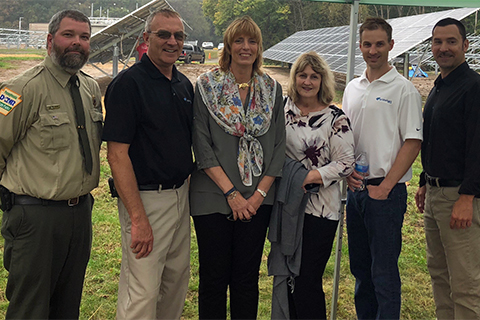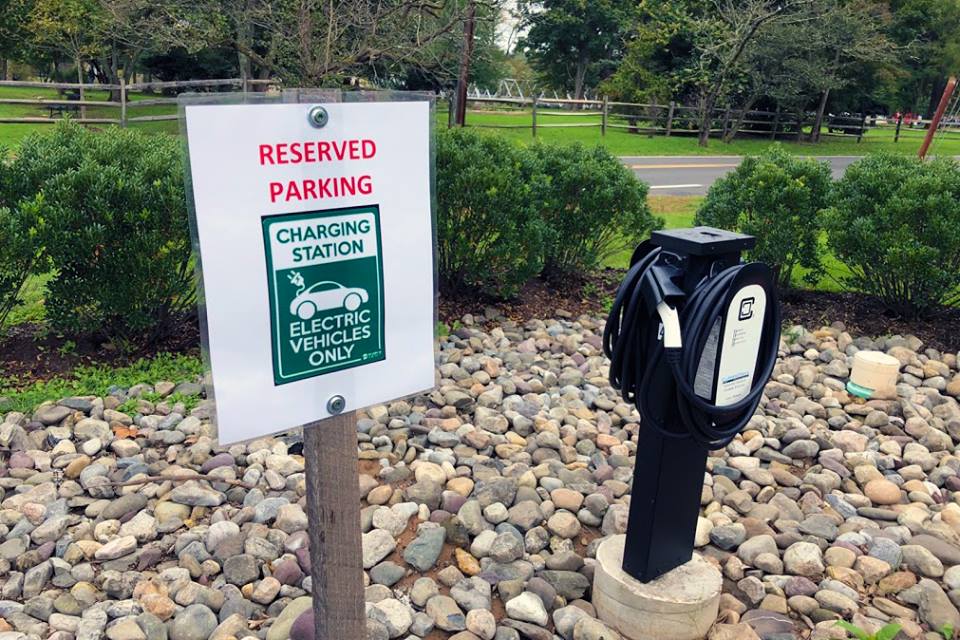The millions of acres of Pennsylvania’s state parks and forests include a lot of buildings such as visitor centers, cabins, and bathrooms. In fact, the Department of Conservation and Natural Resources oversees more than 4,500 buildings and 100 wastewater treatment facilities.
To support operations, DCNR has thousands of vehicles in its fleet across the state, and spends millions of dollars a year in electricity.
The department is focused on the responsible use of agency resources while promoting sustainable best practices. Toward that goal, the department is:
- Employing energy efficiency measures
- Building roads, bridges, trails, and culverts that can withstand flooding
- Attracting outside and federal funding for best practices
- Encouraging volunteers
In October, Secretary Cindy Adams Dunn and other DCNR staff spent some time in western Pennsylvania highlighting several ways the department is going green.
Identifying Ways for Even More Improvement in Energy Efficiency
The heavily visited Ohiopyle State Park visitor center in Fayette County was the first stop on the sustainability tour.
“We have upgraded our lighting and HVAC systems in a building that already is at the highest efficiency standards,” said Dunn. “With these improvements to its LEED Gold visitor center, DCNR signals a commitment to sustainability.
“Looking ahead to mid-2019, DCNR will begin infrastructure improvements benefitting about 50 state parks and 12 forest districts.”
Working in cooperation with the Department of General Services, and using the Guaranteed Energy Savings Act (GESA) program, DCNR contracted with Energy Systems Group of Portersville, Pa., to provide infrastructure investments that will save $7.5 million over 20 years.
Saving Big with Solar Power

Using clean energy from the sun, DCNR is deploying small scale solar arrays to take certain buildings and facilities to net-zero, saving money and reducing DCNR’s carbon footprint.
What is net-zero energy consumption? It means the total amount of energy used by the building on an annual basis is roughly equal to the amount of renewable energy created on site – in this case from the sun.
Also on the tour was a stop at Moraine State Park to help dedicate a solar power installation installed by Spotts Brothers, Inc. of Schuylkill Haven.
While sewage treatment plants aren’t interesting to most, they are among the highest users of energy in the DCNR system, so it makes sense to address them.
The 230kW solar array at Moraine will provide enough energy to operate the new sewage treatment plant, taking the facility to net-zero energy consumption. The arrays will save the Butler County park $25,000 annually.
Encouraging Electric Cars: Charging Stations for Visitors

You might know that in Pennsylvania, there is a state park within 25 miles of every resident. In addition to being great for those who enjoy nature and outdoor fun, parks and forests can provide a good resource to assist the growing number of people driving electric cars.
DCNR has analyzed its entire fleet and is deploying electric vehicles and charging stations in locations most suitable, including installing charging stations for public use.
On the final stop of the Sustainability Tour, Secretary Dunn joined Bureau of State Parks officials in dedicating an electric car charging station at Prince Gallitzin State Park in Cambria County. Similar installations will be going in at more than 40 state parks and forests to help reduce greenhouse gases, lessen smog, and improve air quality.
The stations can fully charge vehicles in 2.5 to 7 hours. Plug-in hybrid vehicles typically drive for 10-50 miles using only electricity before they start using gasoline.
“We know thousands of state residents own electric or plug-in hybrid vehicles,” Dunn said. “We also know many parks and forest destinations are in remote locations, and the ability to travel to and from them in electric vehicles has been limited by charging availability.”
Another station is in place at Kinzua Bridge, McKean County, a focal point of the Pennsylvania Wilds. Check the news release for the full list of parks.
As the state’s leading conservation agency, DCNR strives to follow practices that conserve and sustain natural resources. To learn more, read about DCNR’s green and sustainable initiative.